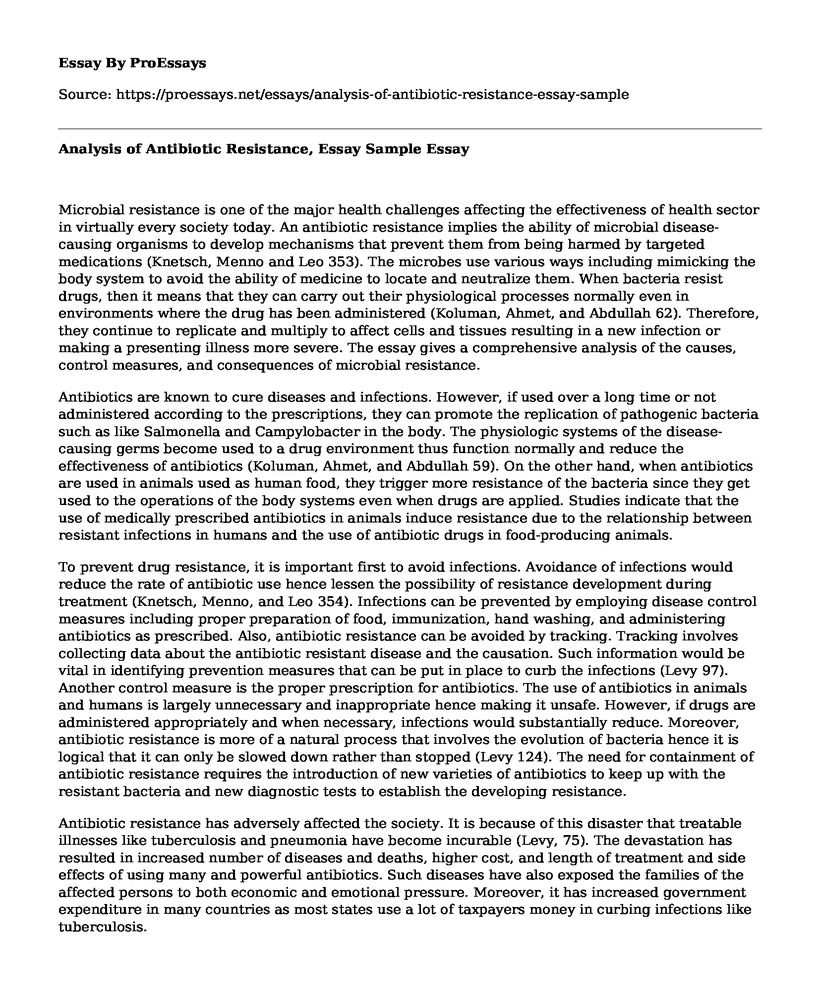Microbial resistance is one of the major health challenges affecting the effectiveness of health sector in virtually every society today. An antibiotic resistance implies the ability of microbial disease-causing organisms to develop mechanisms that prevent them from being harmed by targeted medications (Knetsch, Menno and Leo 353). The microbes use various ways including mimicking the body system to avoid the ability of medicine to locate and neutralize them. When bacteria resist drugs, then it means that they can carry out their physiological processes normally even in environments where the drug has been administered (Koluman, Ahmet, and Abdullah 62). Therefore, they continue to replicate and multiply to affect cells and tissues resulting in a new infection or making a presenting illness more severe. The essay gives a comprehensive analysis of the causes, control measures, and consequences of microbial resistance.
Antibiotics are known to cure diseases and infections. However, if used over a long time or not administered according to the prescriptions, they can promote the replication of pathogenic bacteria such as like Salmonella and Campylobacter in the body. The physiologic systems of the disease-causing germs become used to a drug environment thus function normally and reduce the effectiveness of antibiotics (Koluman, Ahmet, and Abdullah 59). On the other hand, when antibiotics are used in animals used as human food, they trigger more resistance of the bacteria since they get used to the operations of the body systems even when drugs are applied. Studies indicate that the use of medically prescribed antibiotics in animals induce resistance due to the relationship between resistant infections in humans and the use of antibiotic drugs in food-producing animals.
To prevent drug resistance, it is important first to avoid infections. Avoidance of infections would reduce the rate of antibiotic use hence lessen the possibility of resistance development during treatment (Knetsch, Menno, and Leo 354). Infections can be prevented by employing disease control measures including proper preparation of food, immunization, hand washing, and administering antibiotics as prescribed. Also, antibiotic resistance can be avoided by tracking. Tracking involves collecting data about the antibiotic resistant disease and the causation. Such information would be vital in identifying prevention measures that can be put in place to curb the infections (Levy 97). Another control measure is the proper prescription for antibiotics. The use of antibiotics in animals and humans is largely unnecessary and inappropriate hence making it unsafe. However, if drugs are administered appropriately and when necessary, infections would substantially reduce. Moreover, antibiotic resistance is more of a natural process that involves the evolution of bacteria hence it is logical that it can only be slowed down rather than stopped (Levy 124). The need for containment of antibiotic resistance requires the introduction of new varieties of antibiotics to keep up with the resistant bacteria and new diagnostic tests to establish the developing resistance.
Antibiotic resistance has adversely affected the society. It is because of this disaster that treatable illnesses like tuberculosis and pneumonia have become incurable (Levy, 75). The devastation has resulted in increased number of diseases and deaths, higher cost, and length of treatment and side effects of using many and powerful antibiotics. Such diseases have also exposed the families of the affected persons to both economic and emotional pressure. Moreover, it has increased government expenditure in many countries as most states use a lot of taxpayers money in curbing infections like tuberculosis.
Microbial resistance has increased the complexity of medical administration and diagnosis as curable diseases have become incurable posing a significant burden on the current society. This is enough evidence that microbial resistance is a major health hazard and should be controlled at all cost.
Works Cited
Koluman, Ahmet, and Abdullah Dikici. "Antimicrobial resistance of emerging foodborne pathogens: status quo and global trends." Critical reviews in microbiology 39.1 (2013): 57-69.
Knetsch, Menno LW, and Leo H. Koole. "New strategies in the development of antimicrobial coatings: the example of increasing usage of silver and silver nanoparticles." Polymers 3.1 (2011): 340-366.
Levy, Stuart B. The antibiotic paradox: how miracle drugs are destroying the miracle. Springer, 2013.
Cite this page
Analysis of Antibiotic Resistance, Essay Sample. (2021, Jun 18). Retrieved from https://proessays.net/essays/analysis-of-antibiotic-resistance-essay-sample
If you are the original author of this essay and no longer wish to have it published on the ProEssays website, please click below to request its removal:
- My Work Experience as a Registered Nurse Paper Example
- Organizations That Have Aided in Eradicating Social Problems Paper Example
- Compare and Contrast Essay on Breastfeeding and Formula Feeding
- Essay Sample on Food Rules
- Essay Sample on Evaluating Leadership Competencies for Nursing Professionals
- Mayo Clinic: Leading Nonprofit for Health Research and EHR Implementation - Research Paper
- Free Research Paper Sample on Early Childhood Education During the COVID-19 Pandemic: Anthropology and Education







